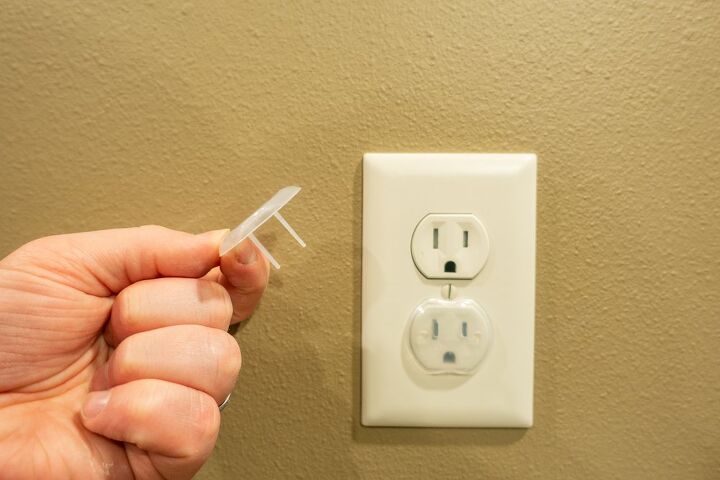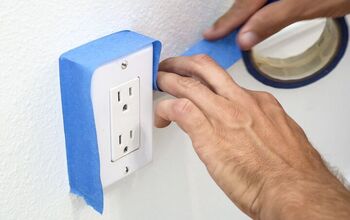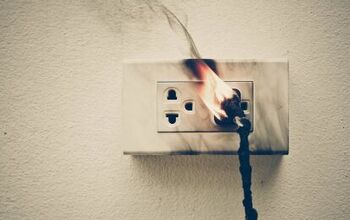Is It Safe To Cover An Electrical Outlet? (Find Out Now!)

If you have recently relocated an outlet in your home, you may be left with an empty or dead outlet on the wall. While the dead outlet is certainly not harming anything, it can be unsightly if the outlet is no longer used. Hiding or covering the outlet can be tempting, especially to make your home look nicer without an ugly outlet on the wall.
It is safe to cover a dead outlet with drywall by cutting out and removing the dead wires and replacing the empty electrical box with spray foam and a drywall patch. Covering a live electrical outlet can lead to overheating and can be a potential danger. For unused active outlets, plastic outlet covers are an affordable, safe, and convenient solution.
Of course, there are decorative ways that homeowners will hide unsightly outlets. Some people will choose to move furniture or picture frames over an electrical outlet. Always be sure there is enough space around the outlet to prevent fire should the outlet overheat. Using tape to cover an outlet can be an immediate solution but should never be a permanent solution to protect an electrical outlet, especially on a live outlet.
Do You Need to Hire an Electrician?
Get free, zero-commitment quotes from pro contractors near you.

Can Covering an Outlet Cause a Fire?
If the outlet is still active, covering the outlet without an approved method can cause a fire. Even with the right practices and with nothing plugged into the outlet, the outlet can overheat. An outlet can overheat if there is faulty wiring or if the circuit in the house overloads. When the outlet overheats, it can easily catch fire. Unfortunately, anything used to cover the outlet will be in the range of the fire, potentially creating a dangerous situation.
However, it is perfectly safe to cover a dead outlet that does not have power running through the wires. A dead outlet may exist if you have recently moved the outlet to another location in the home. Covering a dead outlet with drywall is a perfectly acceptable and welcomed project for any homeowner.
What Tools Will I Need to Cover an Outlet with Drywall?
Luckily, you’ll only need some basic tools to be able to cover your dead outlet with drywall. For this project, you’ll need:
- Screwdriver
- Wire snippers or cutters
- Tape Measurer
- Utility knife or drywall saw
You’ll always want the necessary materials to make the repair. Necessary supplies include purchasing a small section of the drywall, drywall tape and compound, spray foam, and the matching primer and paint for the room where you are making the new drywall patch to cover the outlet.
How Can I Safely Cover an Electrical Outlet with Drywall?
If you have a dead outlet in your wall that does not have live power, it is possible to cover the outlet safely with drywall. This method is commonly used in homes that have relocated the outlet to a different area of the room. To safely cover an electrical outlet with drywall, you’ll want to:
Step 1: Turn Off Power
Before attempting any electrical work in the house, it is best to turn off the power to the circuit you will be working with.
Step 2: Remove the Dead Outlet
You will only want to remove a dead outlet and never drywall over a live outlet. To remove the outlet, you’ll need to unscrew the screws holding the outlet into place with a screwdriver. Pull the outlet away from the wall and disconnect the wires attached to the terminals. You can cut wires inserted through the back of the outlet box if you cannot access them otherwise.
Step 3: Remove Power Cable
Next, remove the power cable from the electrical box. There may be a second cable that can be removed as well. Remove the cable from the wall by pulling it through the attic or the basement.
Step 4: Measure and Cut
Measure the dimensions of the outlet box and cut a piece of drywall to fit inside the opening. You may want to use a utility knife or a drywall saw.
Step 5: Fill With Foam
For better insulation, use spray foam to fill the now-empty electrical box. Allow the foam to expand outside the box, and when dry, cut the excess foam, so it is flush with the drywall. You may want to wear gloves during this step to avoid contamination with the sticky foam.
Step 6: Patch and Paint
Lastly, you’ll want to insert the cut piece of drywall and patch the hole. Use drywall tape along the seams and drywall compound to create a smooth edge. Once the compound has dried, sand the area smooth and apply paint to conceal the area where an outlet once was.
How Can I Tell If An Outlet Has Live Wires?
Covering an outlet with drywall is ideal if the outlet has dead wires and the outlet is no longer in use. Determining if the outlet has live wires is an easy practice that anyone can do with basic tools.
The best way to test an outlet to determine if it has live power is to use a multimeter. You’ll want to insert the leads into the outlet slots. If the test reads a voltage across the outlet or the tester lights illuminate, you know that power is going through the outlet, and the wires are considered live.
Is it Safe to Cover an Outlet with Tape?
Although it may be tempting to cover an outlet with tape to prevent pets and children from gaining access to the outlet itself, this is a dangerous idea. While electrical and duct tape will work to cover the outlet receptacle, this is not a permanent solution. Because the electrical portions of an outlet are recessed, there is no danger of transferring heat or electricity to the tape, causing a fire.
However, for a long-term solution, the tape shouldn’t be used. Instead, cut power to the outlet entirely or use an electrical plate to block access to the outlet.
Do You Need to Hire an Electrician?
Get free, zero-commitment quotes from pro contractors near you.

Related Questions
What creative ways can I cover a working electrical outlet?
Covering an unused outlet with drywall is a permanent solution to a non-functioning outlet in your home. But, sometimes, you simply don’t like the look of a visible outlet on the wall. There are some creative ways to hide an active outlet while still keeping your home safe.Some of the most popular ways to hide an active outlet include moving a piece of furniture in front of the outlet or hiding the outlet behind a picture frame. Always leave enough room between the outlet and your cover to prevent possible overheating and fire. You can purchase a hollow box with a small opening to allow a cord to pass through while still covering the outlet.Or, there is also the option to hire a professional electrician to install a pop-out outlet or a hinged outlet for a modern and sleek way to camouflage a functioning outlet.
How do you cover unused outlets?
If you have an outlet in your home that you don’t use but still want to cover, you can buy a plastic outlet cap to insert into the outlet. These small plastic caps are extremely easy to use and are a great safety measure for homes with small children or pets. Plastic caps for outlets can be purchased at any hardware store or home improvement store. The best part about outlet caps is the fact that they are non-permanent, so the caps can simply be removed when you are ready to use the outlet again.

We are a team of passionate homeowners, home improvement pros, and DIY enthusiasts who enjoy sharing home improvement, housekeeping, decorating, and more with other homeowners! Whether you're looking for a step-by-step guide on fixing an appliance or the cost of installing a fence, we've here to help.
More by Upgraded Home Team















![How To Reset A Whirlpool Cabrio Washer [In 5 Easy Steps!]](https://cdn-fastly.upgradedhome.com/media/2023/07/31/9076531/how-to-reset-a-whirlpool-cabrio-washer-in-5-easy-steps.jpg?size=350x220)








![10 Most Dangerous Neighborhoods in Baltimore [Updated]](https://cdn-fastly.upgradedhome.com/media/2023/07/31/9075655/10-most-dangerous-neighborhoods-in-baltimore-updated.jpg?size=350x220)


